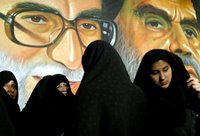Democracy in Iran
In the latest issue of The Economist, editors critique a new book about Iranian politics, Democracy in Iran : History and the Quest for Liberty by Ali Gheissari and Vali Nasr.Politics in Iran
Shadows of uncertainty
"IF EVER policymakers in Washington, DC, needed a slim, thoughtful account of Iran's experiments with pluralism and democracy, now surely is the time. Ali Gheissari, a historian at the University of San Diego, and Vali Nasr, who teaches political science at the Naval Postgraduate School in Monterey, California, set out to challenge the assumption that modern Iranian history is essentially about the conflict between Iranian regimes and their citizens...
"The authors argue that ever since 1906, when a coalition of clerical grandees, progressive intellectuals and bazaar traders forced the shah of the time to promulgate Iran's first constitution and establish a parliament, Iranians have been struggling to accommodate the competing attractions of liberty and the rule of law, on one hand, and stability—often imposed with an iron fist—on the other.
"The authors find that true democrats, in the Western sense, were strongest before and immediately after the [1979] revolution; they were swiftly overwhelmed by the supporters of Ayatollah Ruhollah Khomeini.

"The Islamic Republic that followed—a 'pragmatic authoritarian regime' that has held no fewer than 37 national elections—has further muddied the picture. The authors find that democratic instincts have flourished to a surprising degree in this most ideological and centralised of political systems...
“'A century after the Constitutional Revolution of 1906', Messrs Gheissari and Nasr conclude, 'Iran is still grappling with how to achieve a democratic state.' The ability of outsiders to nudge the country in a hopeful direction remains limited..."



0 Comments:
Post a Comment
<< Home